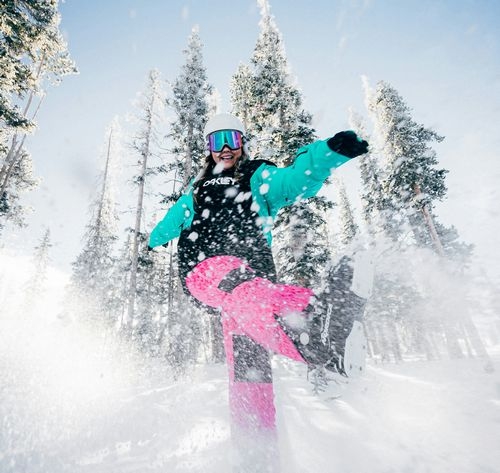How to Ski with Prescription Glasses?
Skiing with prescription glasses can be tricky! Indeed, they tend to fog up and become uncomfortable under your goggles. Our team at Nevada, specialists in ski hire in Les Gets, explain the various solutions for skiing with clear vision:
Skiing with Over-The-Glasses (OTG) Goggles:
OTG ski goggles are the most common solution for those who want to ski with prescription glasses. These goggles are specifically designed to work with prescription glasses underneath. OTG goggles differ from regular goggles in two crucial areas: where the goggle foam touches your face and the area between your helmet and the goggles. These two zones allow you to ski comfortably with your glasses without fogging.
OTG goggles are shaped specifically to provide enough space for your glasses to naturally rest on your face, without crushing them against your cheeks or pushing them up your nose. This means their frames are generally more spacious than those of regular goggles. The lens is a bit further away from your eyes, and there is often slightly thicker foam on the edges to create a seal around the arms of your glasses without crushing them. Some goggles not labeled as OTG may still work well with your glasses, so it's always a good idea to try them on before purchasing.
But OTG goggles must not only fit well with glasses; they also need to ventilate well to prevent your glasses from fogging up. There are several ways to achieve this. The simplest is to have more ventilation openings around the edge of the goggles to allow your face to breathe without fogging any of the lenses. This works well for most people and is how most OTG goggle manufacturers solve this problem.
However, if you tend to sweat a lot and fog up your glasses, there are OTG goggles with a built-in ventilation fan equipped with a small battery. This adds weight to the goggle, and you need to remember to recharge the battery, but if regular OTG goggles don't work for you, this is the solution to consider.
In our store in Les Gets, you will find a selection of OTG goggles from the Loubsol brand to allow you to ski with peace of mind and without fogging.
Skiing with Prescription Sunglasses:
If you have prescription sunglasses, you can ski with them. However, make sure the UV protection is sufficient. With the sun reflecting off the snow, you will need a pair of Category 4 sunglasses to avoid burning your retinas.
Moreover, the frames must be sturdy enough not to break in case of a fall, which could lead to facial lacerations. In case of bad weather (snow or wind), it is much more uncomfortable to ski with sunglasses, as goggles provide better protection against the elements. You can simply bring OTG goggles and slide your prescription glasses under them if the weather changes.
Skiing with Contact Lenses:
If you can wear contact lenses, it's the most convenient option. They will not fog up, no matter how fast you ski!
It is recommended to wear daily disposable contact lenses. They will provide better vision throughout the day. It is also preferable to wear lenses with UV protection. Your eyes will be protected even after removing your goggles to enjoy lunch or a drink in the sun.
Skiing with Inserts Adapted to Your Prescription:
Inserts are simply frameless lenses adapted to your prescription to be inserted directly into your goggles. This allows you to avoid the inconvenience of frames. However, inserts are more expensive than a simple OTG goggle where you can slide your glasses.
How to Avoid Fogging with Your Prescription Glasses?
In addition to having an OTG ski goggle, there are other tips to avoid fogging in your glasses.
- Pay attention to your frames. Large frames may look very stylish but are much less practical when it comes to skiing. Thin and flexible frames will be much more convenient to wear under a ski goggles all day. In addition to being more comfortable, they will also be much less dangerous in case of a fall. This way, you will avoid the risk of pushing your frames into your face after an uncontrolled snowboard turn.
- vbnet Copy code
- Avoid large temperature differences. Fogging is caused by a temperature difference between the air inside and outside the goggles or your glasses. So do your best to keep these temperatures equal: Never leave your glasses on your forehead, the sweat from your head will fog them up quickly.
- If you take off your glasses to enter a chalet, do not put them back on immediately when you come back out. Wait for a minute for your face to cool down.
- Do not cover your mouth. Or at least, make sure your neck gaiter does not direct the warm air from your nose and mouth toward your goggles.
- Naturally dry your goggles after your day of skiing to reduce recurring fogging.
- Never rub the inside of your goggles when it is wet. With an anti-fog treatment, you will remove it by cleaning it when it is wet. Clean it only when it is dry.
